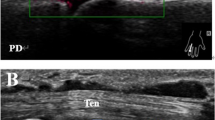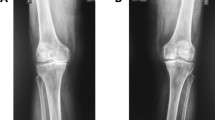Abstract
In the current paradigm for management of patients with rheumatoid arthritis (RA), obtaining clinical remission of symptoms remains the most important aim, but achieving radiographic remission is another key goal of treatment. Several parameters detectable by musculoskeletal ultrasonography can predict the development of severe RA, as well as monitor patients' responses to treatment; thus, musculoskeletal ultrasonography is widely used for evaluating patients with RA, both in clinical trials and in clinical practice. This Review describes the applications of musculoskeletal ultrasonography in patients with RA, focusing on the identification of ultrasonographic features that predict the development of erosions. Such predictive markers include high vascularity of synovitis, persistent synovitis, tenosynovitis of the extensor carpi ulnaris tendon, and erosive changes in the distal ulna. This article also describes ultrasonographic scores that could feasibly be integrated into daily rheumatology practice for the evaluation of patients with RA.
Key Points
-
The use of musculoskeletal ultrasonography is widely established in the field of rheumatology, both in clinical studies and in clinical practice
-
Grayscale and power or color Doppler ultrasonography are used to assess patients with rheumatoid arthritis (RA) in clinical practice and research; contrast-enhanced ultrasonography is currently only used in research
-
Several ultrasonographic parameters can predict the development of severe erosive RA and, therefore, have a potential role as imaging biomarkers
-
Ultrasonography sum scores involve assessment of a reduced number of joints compared with radiographic scores, which could speed up clinical examination time
-
Although ultrasonography sum scores accurately reflect overall RA disease activity, consensus on an international musculoskeletal ultrasonography score has not been reached yet
This is a preview of subscription content, access via your institution
Access options
Subscribe to this journal
Receive 12 print issues and online access
$209.00 per year
only $17.42 per issue
Buy this article
- Purchase on Springer Link
- Instant access to full article PDF
Prices may be subject to local taxes which are calculated during checkout



Similar content being viewed by others
References
Backhaus, M. et al. Arthritis of the finger joints: a comprehensive approach comparing conventional radiography, scintigraphy, ultrasound, and contrast-enhanced magnetic resonance imaging. Arthritis Rheum. 42, 1232–1245 (1999).
Backhaus, M. et al. Prospective two year follow up study comparing novel and conventional imaging procedures in patients with arthritic finger joints. Ann. Rheum. Dis. 61, 895–904 (2002).
Scheel, A. K. et al. Prospective 7 year follow up imaging study comparing radiography, ultrasonography, and magnetic resonance imaging in rheumatoid arthritis finger joints. Ann. Rheum. Dis. 65, 595–600 (2006).
Szkudlarek, M. et al. Ultrasonography of the metatarsophalangeal joints in rheumatoid arthritis: comparison with magnetic resonance imaging, conventional radiography, and clinical examination. Arthritis Rheum. 50, 2103–2112 (2004).
Brown, A. K. et al. Presence of significant synovitis in rheumatoid arthritis patients with disease-modifying antirheumatic drug-induced clinical remission: evidence from an imaging study may explain structural progression. Arthritis Rheum. 54, 3761–3773 (2006).
Brown, A. K. et al. An explanation for the apparent dissociation between clinical remission and continued structural deterioration in rheumatoid arthritis. Arthritis Rheum. 58, 2958–2967 (2008).
Scirè, C. A. et al. Ultrasonographic evaluation of joint involvement in early rheumatoid arthritis in clinical remission: power Doppler signal predicts short-term relapse. Rheumatology (Oxford) 48, 1092–1097 (2009).
Peluso, G. et al. Clinical and ultrasonographic remission determines different chances of relapse in early and long standing rheumatoid arthritis. Ann. Rheum. Dis. 70, 172–175 (2011).
Foltz, V. et al. Power Doppler ultrasound, but not low-field magnetic resonance imaging, predicts relapse and radiographic disease progression in rheumatoid arthritis patients with low levels of disease activity. Arthritis Rheum. 64, 67–76 (2012).
Backhaus, M. et al. Guidelines for musculoskeletal ultrasound in rheumatology. Ann. Rheum. Dis. 60, 641–649 (2001).
Wakefield, R. J. et al. Musculoskeletal ultrasound including definitions for ultrasonographic pathology. J. Rheumatol. 32, 2485–2487 (2005).
Ohrndorf, S. & Backhaus, M. Advances in sonographic scoring of rheumatoid arthritis. Ann. Rheum. Dis. http://dx.doi.org/10.1136/annrheumdis-2012-202197.
Bruyn, G. A. W. & Schmidt, W. A. Introductory Guide to Musculoskeletal Ultrasound for the Rheumatologist. 2nd edn (Springer, 2011).
Strunk, J., Backhaus, M., Schmidt, W. & Kellner, H. Color Doppler sonography for investigation of peripheral joints and ligaments [German]. Z. Rheumatol. 69, 164–170 (2010).
Feinstein, S. B. The powerful microbubble: from bench to bedside, from intravascular indicator to therapeutic delivery system, and beyond. Am. J. Physiol. Heart Circ. Physiol. 287, H450–H457 (2004).
Forsberg, F. et al. Comparison of fundamental and wideband harmonic contrast imaging of liver tumors. Ultrasonics 38, 110–113 (2000).
Albrecht, T. et al. Phase-inversion sonography during the liver-specific late phase of contrast enhancement: improved detection of liver metastases. AJR Am. J. Roentgenol. 176, 1191–1198 (2001).
Quaia, E. et al. Characterization of focal liver lesions with contrast specific US modes and a sulfur hexafluoride-filled microbubble contrast agent: diagnostic performance and confidence. Radiology 232, 420–430 (2004).
Solbiati, L., Tonolini, M., Cova, L. & Goldberg, S. N. The role of contrast-enhanced ultrasound in the detection of focal liver leasions. Eur. Radiol. 11 E15–E26 (2001).
Klauser, A. et al. The value of contrast-enhanced color Doppler ultrasound in the detection of vascularization of finger joints in patients with rheumatoid arthritis. Arthritis Rheum. 46, 647–653 (2002).
Klauser, A. et al. Contrast enhanced gray-scale sonography in assessment of joint vascularity in rheumatoid arthritis: results from the IACUS study group. Eur. Radiol. 15, 2404–2410 (2005).
De Zordo, T. et al. Value of contrast-enhanced ultrasound in rheumatoid arthritis. Eur. J. Radiol. 64, 222–230 (2007).
Ohrndorf, S. et al. Contrast-enhanced ultrasonography is more sensitive than grayscale and power Doppler ultrasonography compared to MRI in therapy monitoring of rheumatoid arthritis patients. Ultraschall. Med. 32 (Suppl 2), E38–E44 (2011).
Wink, M. H., Wijkstra, H., de la Rosette, J. J. & Grimbergen, C. A. Ultrasound imaging and contrast agents: a safe alternative to MRI? Minim. Invasive Ther. Allied Technol. 15, 93–100 (2006).
Hama, M. et al. Power Doppler ultrasonography is useful for assessing disease activity and predicting joint destruction in rheumatoid arthritis patients receiving tocilizumab—preliminary data. Rheumatol. Int. 32, 1327–1333 (2012).
Yamada, S. et al. Very early improvements in the wrist and hand assessed by power Doppler sonography predicting later favorable responses in tocilizumab-treated patients with rheumatoid arthritis. Arthritis Care Res. (Hoboken) 63, 1477–1481 (2011).
Mandl, P. et al. Metrological properties of ultrasound versus clinical evaluation of synovitis in rheumatoid arthritis: results of a multicenter randomized, study. Arthritis Rheum. 64, 1272–1282 (2012).
Fukae, J. et al. Radiographic prognosis of finger joint damage predicted by early alteration in synovial vascularity in patients with rheumatoid arthritis: potential utility of power Doppler sonography in clinical practice. Arthritis Care Res. (Hoboken) 63, 1247–1253 (2011).
Dougados, M. et al. The ability of synovitis to predict structural damage in rheumatoid arthritis: a comparative study between clinical examination and ultrasound. Ann. Rheum. Dis. http://dx.doi.org/10.1136/annrheumdis-2012-201469.
Filippucci, E. et al. Hand tendon involvement in rheumatoid arthritis: an ultrasound study. Semin. Arthritis Rheum. 41, 752–760 (2012).
Lillegraven, S. et al. Tenosynovitis of the extensor carpi ulnaris tendon predicts erosive progression in early rheumatoid arthritis. Ann. Rheum. Dis. 70, 2049–2050 (2011).
Hammer, H. B., Haavardsholm, E. A., Bøyesen, P. & Kvien, T. K. Bone erosions at the distal ulna detected by ultrasonography are associated with structural damage assessed by conventional radiography and MRI: a study of patients with recent onset rheumatoid arthritis. Rheumatology (Oxford) 48, 1530–1532 (2009).
Hobson-Webb, L. D., Massey, J. M., Juel, V. C. & Sanders, D. B. The ultrasonographic wrist-to-forearm median nerve area ratio in carpal tunnel syndrome. Clin. Neurophysiol. 119, 1353–1357 (2008).
Karadag, O. et al. Sonographic assessment of carpal tunnel syndrome in rheumatoid arthritis: prevalence and correlation with disease activity. Rheumatol. Int. 32, 2313–2319 (2012).
Klauser, A. S. et al. carpal tunnel syndome assessment with US: value of additional cross-sectional area measurements of the median nerve in patients versus healthy volunteers. Radiology 250, 171–177 (2009).
Manger, B. & Kalden, J. R. Joint and connective tissue ultrasonography—a rheumatologic bedside procedure? Arthritis Rheum. 38, 736–742 (1995).
Naredo, E. et al. Ultrasonographic assessment of inflammatory activity in rheumatoid arthritis: comparison of extended versus reduced joint evaluation. Clin. Exp. Rheumatol. 23, 881–884 (2005).
Naredo, E. et al. Validity, reproducibility, and responsiveness of a twelve-joint simplified power Doppler ultrasonographic assessment of joint inflammation in rheumatoid arthritis. Arthritis Rheum. 59, 515–522 (2008).
Backhaus, M. et al. Evaluation of a novel 7-joint ultrasound score in daily rheumatologic practice: a pilot project. Arthritis Rheum. 61, 1194–1201 (2009).
Backhaus, T. M. et al. Sensitivity to change of the US7 score among 432 patients with rheumatoid arthritis over 12 months of therapy. Ann. Rheum. Dis. http://dx.doi.org/10.1136/annrheumdis-2012-201397.
Ohrndorf, S. et al. Reliability of the novel 7-joint ultrasound score: results from an inter- and intraobserver study performed by rheumatologists. Arthritis Care Res. (Hoboken) 64, 1238–1243 (2012).
Hammer, H. B. & Kvien, T. Comparisons of 7- to 78-joint ultrasonography scores: all different joint combinations show equal response to adalimumab treatment in patients with rheumatoid arthritis. Arthritis Res. Ther. 13, R78 (2011).
Ellegaard, K. et al. Ultrasound color Doppler measurements in a single joint as measure of disease activity in patients with rheumatoid arthritis—assessment of concurrent validity. Rheumatology (Oxford) 48, 254–257 (2009).
Hartung, W. et al. Development and evaluation of a novel ultrasound score for large joints in rheumatoid arthritis: one year of experience in daily clinical practice. Arthritis Care Res. (Hoboken) 64, 675–682 (2012).
Naredo, E. et al. The OMERACT Ultrasound Task Force—status and perspectives. J. Rheumatol. 38, 2063–2067 (2011).
Saleem, B. et al. Should imaging be a component of rheumatoid arthritis remission criteria? A comparison between traditional and modified composite remission scores and imaging assessments. Ann. Rheum. Dis. 70, 729–798 (2011).
Wakefield, R. J. et al. After treat-to-target: can a targeted ultrasound initiative improve RA outcomes? Ann. Rheum. Dis. 71, 799–803 (2012).
Acknowledgements
The scientific work of S. Ohrndorf is financially sponsored by the third-party funds of the Bundesministerium für Bildung und Forschung (BMBF) project 'ArthroMark' (subproject no. 7 'Clinical study on Biomarkers and Imaging'), Germany.
Author information
Authors and Affiliations
Contributions
M. Backhaus and S. Ohrndorf contributed equally to all aspects of the manuscript, including researching data for the article, writing the manuscript and review or editing of the manuscript before submission.
Corresponding author
Ethics declarations
Competing interests
The authors declare no competing financial interests.
Rights and permissions
About this article
Cite this article
Ohrndorf, S., Backhaus, M. Musculoskeletal ultrasonography in patients with rheumatoid arthritis. Nat Rev Rheumatol 9, 433–437 (2013). https://doi.org/10.1038/nrrheum.2013.73
Published:
Issue Date:
DOI: https://doi.org/10.1038/nrrheum.2013.73
This article is cited by
-
Ultrasound of sacroiliac joints in spondyloarthritis: a systematic review
Rheumatology International (2018)
-
Patient-provider discordance between global assessments of disease activity in rheumatoid arthritis: a comprehensive clinical evaluation
Arthritis Research & Therapy (2017)
-
Low-Intensity Pulsed Ultrasound Activates Integrin-Mediated Mechanotransduction Pathway in Synovial Cells
Annals of Biomedical Engineering (2014)



